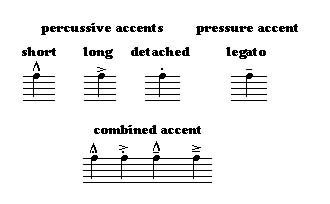 | ||
In music, an accent is an emphasis placed on a particular note or set of notes, either as a result of its context or specifically indicated by an accent mark. Accents contribute to the articulation and prosody of a performance of a musical phrase. Compared to surrounding notes:
Contents
Accents which do not correspond to the stressed beats of the prevailing meter are said to be syncopated.
Agogic accents
There are four kinds of agogic accents :
Accent marks
In music notation, an accent mark indicates a louder dynamic to apply to a single note or an articulation mark. The most common is the horizontal accent, the fourth symbol in the diagram above; this is the symbol that most musicians mean when they say accent mark. The vertical accent, third in the diagram, may be stronger or weaker than the horizontal accent; composers have never been consistent in using these markings. In most musical works this type of accent is meant to be played more forcefully and usually shorter. The remaining marks typically shorten a note.
- Staccato, the first symbol shown above, indicates that the last part of a note should be silenced to create separation between it and the following note. The duration of a staccato note may be about half as long as the note value would indicate, although the tempo and performers' taste varies this quite a bit. In jazz articulation, it is stated as "dit".
- The staccatissimo, shown second, is usually interpreted as shorter than the staccato, but composers up to the time of Mozart used these symbols interchangeably. A staccatissimo crotchet (quarter note) would be correctly played in traditional art music as a lightly articulated semi-quaver (sixteenth note) followed by rests which fill the remainder of the beat.
- The marcato, which is Italian for "well marked", shown third, the vertical open wedge, is generally accepted to be as loud as an accent mark and as short as a staccato. Martellato, Italian for "hammered", is another name for the marcato symbol used primarily by orchestral string musicians as it refers to the specific bowing technique used to create marcato. In jazz articulation, marcato is typically stated as "daht" yet the performing musician may interpret the duration of the note differently depending on what style of jazz he or she is playing.
- The fourth mark shown, the accent mark, indicates that the marked note should have an emphasized beginning and then taper off rather quickly. This mark is correctly known by classically trained musicians as marcato, though it is usually simply referred to as an accent. In jazz articulation, it is stated as "dah".
- The tenuto mark, shown fifth above, has three meanings. It may indicate that a note or chord is to be played at full length or longer; it may indicate that a note or chord is to be played a bit louder; or it may indicate that a note is to be separated with a little space from surrounding notes. The last meaning is usually inferred when there are several notes with tenuto marks in a row, especially under a slur. Tenuto is Italian for "sustained". In jazz articulation, it is stated as "doo".
Even when these symbols are absent, experienced musicians will introduce the appropriate gesture according to the style of the music.
Mark McGrain writes about articulation on page 156 in his book Music Notation: Theory and Technique for Music Notation. The marcato accent in the third mark shown is also known as the forzato accent. The notation commonly known as just an accent is also known as the sforzando accent. Neither of these accents alter the durational value of the note or voicing they attend.
Anti-accent marks
Percussion music in particular makes use as well of anti-accent marks, notated as follows:
- slightly softer than surrounding notes: ◡ (breve)
- significantly softer than surrounding notes: ( ) (note head in parentheses)
- much softer than surrounding notes: [ ] (note head in brackets)
